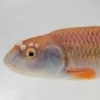how do you exactly differenciate between e. okefenokee and e. gilberti? is there anything obvious to see? i am just interested since both species are quite similar so some of e. gilberti could have been kept under the name of e. okefenokee. that may not be such a big problem in the us with wildlife habitats of these fish, but here in germany there are only small populations in few tanks. since i got several breeding e. okefenokee in my tanks i am really interested in this topic.
I understand how if English is your second language, formal scientific papers can be difficult to understand. Here, I pulled the relevant paragraph out of the paper for you. I have also written an attempt at a translation below.
"Elassoma gilberti is distinguished from its
close relative E. okefenokee by possessing four pores
in the preopercular (PO) canal on each side of the head
and usually seven anal fin rays. Elassoma okefenokee
has three PO pores and usually eight anal fin rays.
Elassoma gilberti has slightly less deep body and slightly
smaller dorsal and anal fins than E. okefenokee. Breeding
females of E. gilberti often have blue dashes below
and behind the eye, which are lacking in female E.
okefenokee. Otherwise, the two species are almost
identical or broadly overlapping in meristic, morphometric,
and color features."
I've read the paper that Uland links to. I can't say I'm an expert in it, but I can try to interpret it for you. From what I can understand, the two major differences are that gilberti females get slightly colorful when breeding (okefenokee females don't) and that gilberti, like other pygmy sunfishes, have four pores while okefenokee have three.
From page 127 of the report:
Gilberti found with three pores: 4. Gilberti found with four pores: 897.
Okefenokee found with three pores: 708. Okefenokee found with four pores: 4.
There are two more differences, but they aren't true for all individuals. On average, okefenokees have longer anal and dorsal fins that gilbertis do. And the average number of fin rays is seven for gilbertis and eight for okefenokees, but both species can be found with either seven or eight fin rays. These two traits can vary by individual. So don't depend on fin size or number of fin rays to determine which species you have. Instead use pore count and female breeding color.
The fact that the females are more colorful is the reason why I was excited when offered gilberti after asking for okefenokee. But so far they've done nothing but hide. *sighs* I'll go feed them microworms right now and see if they can begin to tolerate my presence.
Edited by Okiimiru, 26 August 2010 - 05:44 PM.


 This topic is locked
This topic is locked





